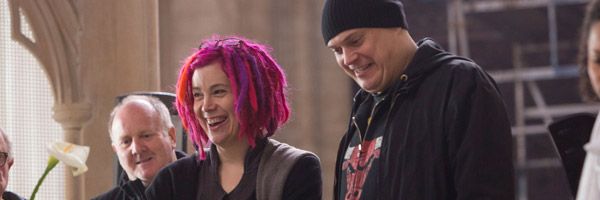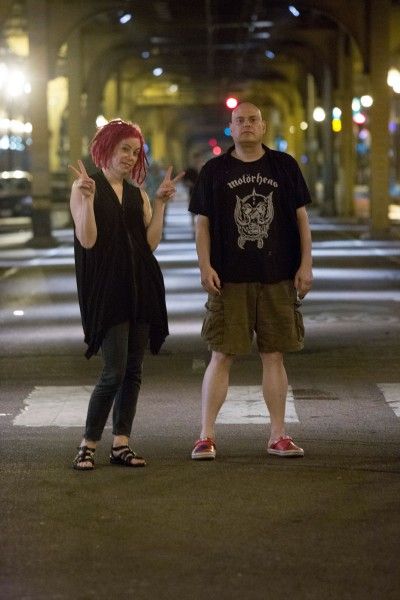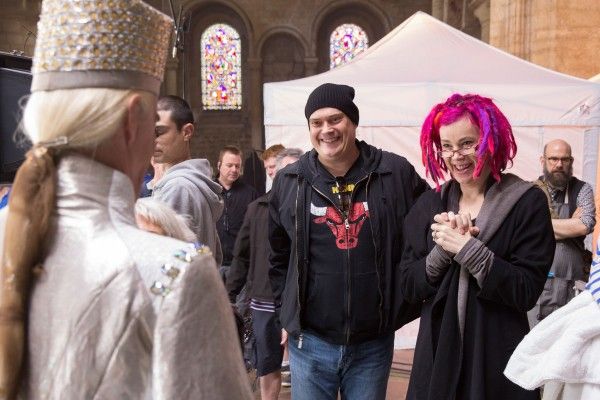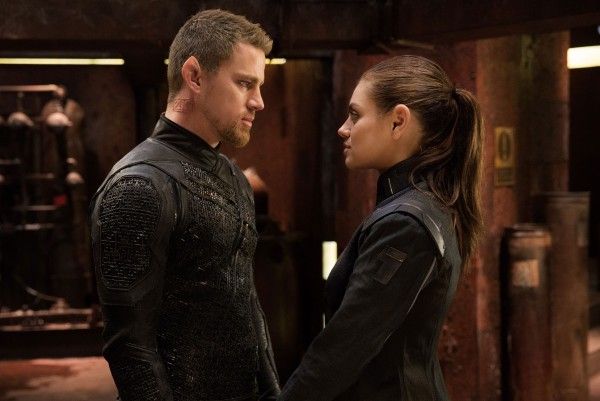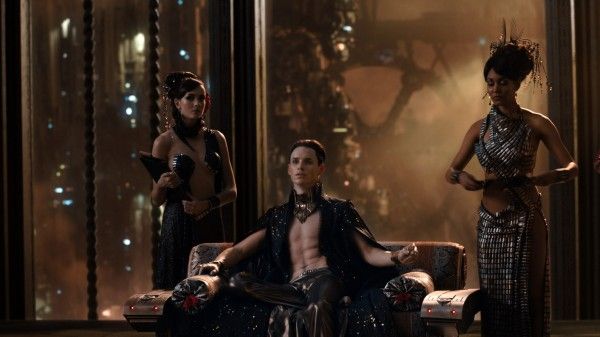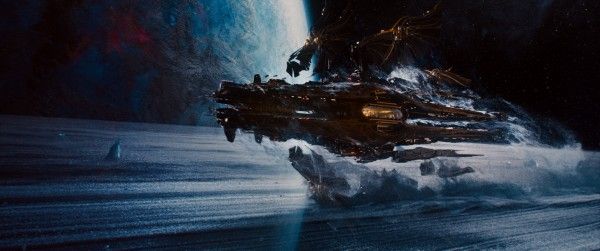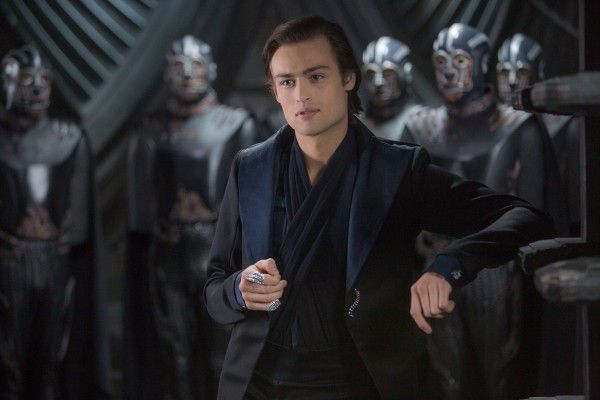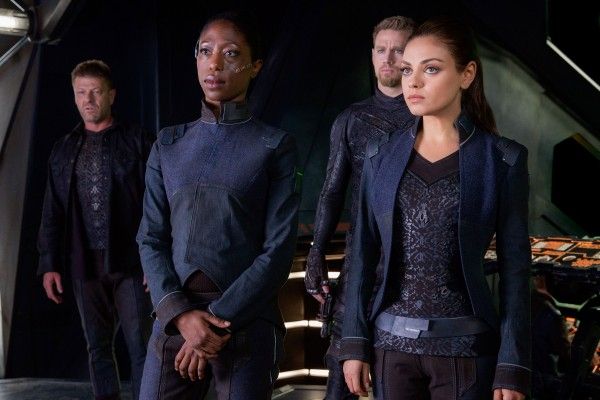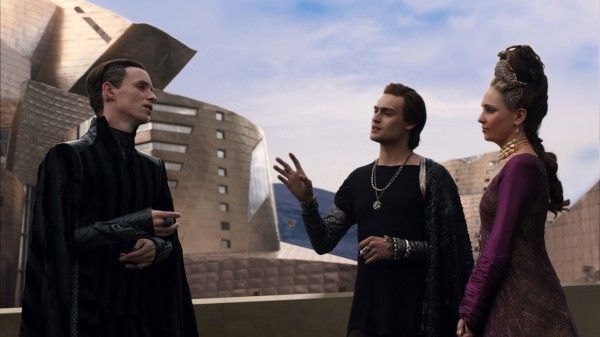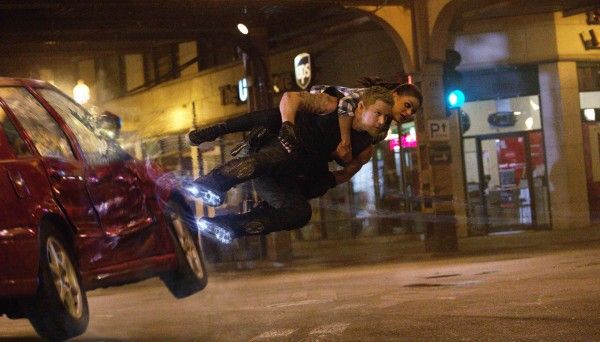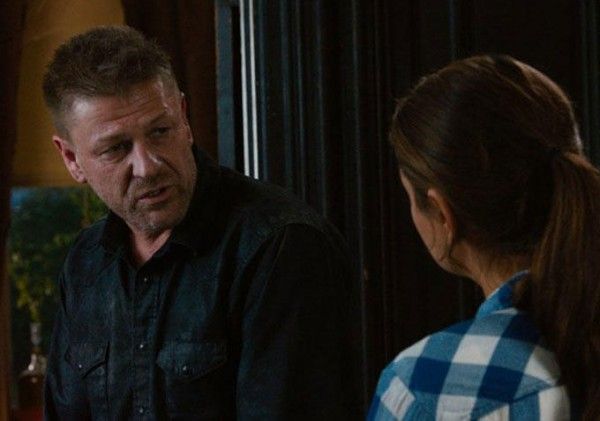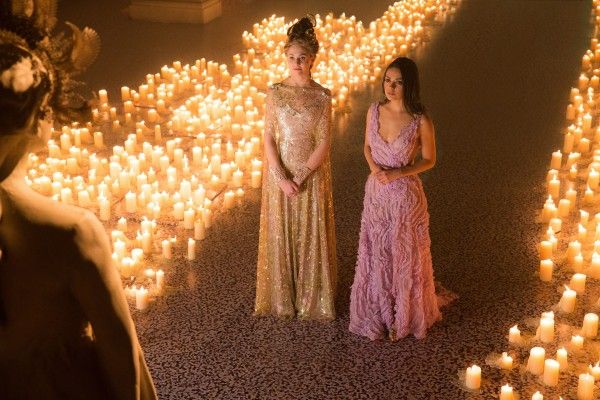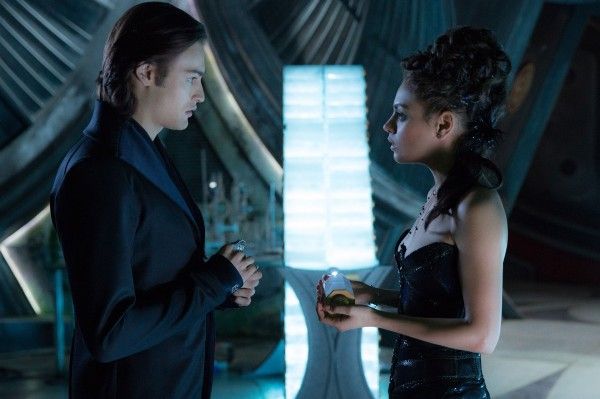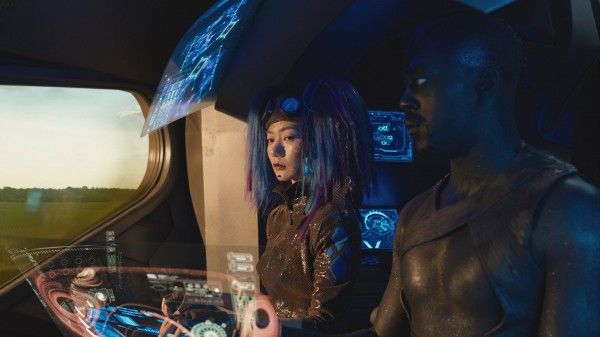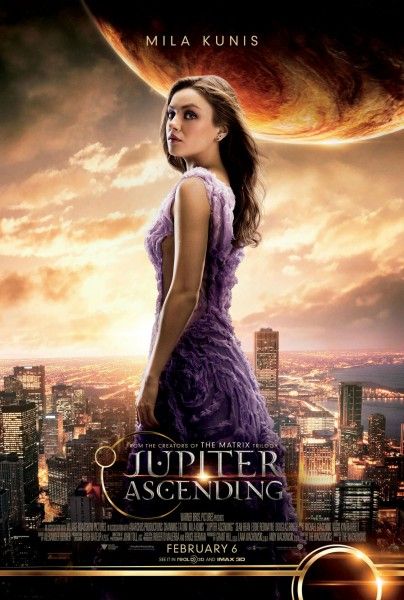A few days ago I got to sit down with Andy and Lana Wachowski to talk about their newest film, Jupiter Ascending. As a huge fan of their work, it was beyond cool to finally meet and talk with the brilliant filmmakers in person.
As you’ve seen in the trailers, the story centers on Jupiter Jones (Mila Kunis), a Russian immigrant who scrubs toilets for a living, but then discovers she has the genetic signature that makes her next in line to be Queen of the Universe. Channing Tatum plays a genetically engineered ex-military hunter tasked with tracking her down. The film also stars Sean Bean, Eddie Redmayne, Douglas Booth, Tuppence Middleton, James D’Arcy, Tim Pigott-Smith and Doona Bae. As you can imagine, the film is loaded with incredible action and insane visual effects.
During our wide ranging conversation, the Wachowskis talked about making a huge sci-fi movie with a female protagonist and if that was ever an issue with the studio, their expanded first draft of the screenplay, the first cut of the film, using 3D for the first time, the unique way in which they created the incredible Chicago action sequence, their Netflix show, Sense8, and a lot more.
For more on Jupiter Ascending, you can click here to check out clips, behind-the-scenes footage, images, posters, and all our previous coverage.
Collider: How are you doing today?
ANDY WACHOWSKI: We’re doing this junket and it’s not something that we normally do, that we seek out.
LANA WACHOWSKI: Yeah, press is kind of like a tool. You have to pay for the privilege of what we get to do for our work.
I say with all sincerity, thank you for letting me make the cut as one of your select interviews today. I greatly appreciate it.
LANA: We like talking about cinema, the art from of cinema, intention, aesthetics, and we find people who like discussing those types of things and we’ll sit down with them.
ANDY: Not easy to do.
LANA: There’s not a lot of you out there.
I can’t remember the last time there was a big sci-fi spectacle like this, with a female protagonist, and I think that’s awesome. Talk a little bit about was that ever an issue, where someone was saying to you, “This sounds cool but we want a male protagonist.”
LANA: Yes, you’re very aware of the way the industry works. I think there’s a funny, sort of corollary subject, which is, make the female more like a male, which is also very common right now at this time period. We were trying to hold on to a female who didn’t have to act like a male to be the protagonist. Yeah, a lot of people said, “Hey, why don’t we make Caine the star of the movie and not Jupiter?” We were like, “No. The story’s about Jupiter.”
ANDY: Yeah, it’s funny. Even industry, not just the studio, has that opinion. Sometimes you’ll run into actors who’ll say, “Whoa. Isn’t this my movie?” So, you’ll get it coming at you from a different angle as well. To Channing’s credit, he was happy to be in more of a supporting role.
LANA: We were super curious if you could make a movie that had the kind of character that Dorothy is in The Wizard of Oz. The Wizard of Oz was kind of a movie we were thinking about when we started thinking about Jupiter. We loved The Wizard of Oz and there aren’t movies like The Wizard of Oz right now. We were like, “Could you take a character like Dorothy who’s a female and who goes on this journey and she doesn’t have to beat people up? She doesn’t have to fight constantly or use weapons and kung fu in order to be the hero. Can she just use empathy?” That was sort of against the grain of what the culture expects or what the culture wants right now. There was some rubbing as we went through the process and I’m sure there will be rubbing in the post process too.
You created in the film a very rich universe with a lot of layers and depth. How long was your story bible? Did you come up with a book that explains everything or was it in your head and you put on the script page what you needed?
ANDY: We don’t really do bibles. We had a fairly extensive timeline because we needed to figure out what the infrastructure was of these space families and these corporations that Earth is a piece of—an asset of. That was fairly extensive. And you have the dinosaurs were here at this point, and okay if you’re farming, at what point are you introducing the human DNA into the species and all that. That was more extensive, timeline-y stuff that we did. But in general our writing is—we always overwrite. All of the backstory to all these characters, including characters that we don’t even meet, are all written and then paired out because our scripts get to be quite lengthy by the end of the process. Jupiter was probably close to 200 pages.
LANA: It was over, I think, 220 because we like to write all the backstory. So, we just write all those scenes.
ANDY: And it’s good for the actors as well because they’ll say, “What’s my character’s motivation here?” We’ll tell them. We’ll be able to say, “Here’s the story.” And we’ll be able to tell the story of how Caine attacked this one guy and where Caine came from. We had this whole sequence where we wanted to show Caine as part of a litter. We would have these little human, space puppies going for their mother’s tit, and they were all battling to get in there like the way that puppies do. We had to get rid of that. That’s cool backstory but let’s get to what the real story is. For Jupiter it was a fairly lengthy process. We wrote it before Cloud Atlas, we’d been working a long time with Warner Bros. to get the right project they were comfortable with.
LANA: One of the big things for us, when you talk about the development of the world, Jupiter had one of the longest preps just because we took some of our favorite artists and we sat down and were like, “Okay. We want to start designing this science fiction world.” One of the things we had never really loved about science fiction in other movies is that they tend towards this mono aesthetic for their science fiction world. It’s usually very utilitarian, it’s one of the ways you express science fiction.
From the beginning we were like, “Why are spaceships so damn ugly?” That was one of our big things. Human beings since the time we were designing chariots and basically litters in Egyptian times through carriages and boats, even Viking ships. They have a beauty and an aesthetic care to them that human beings are always interested in expressing their conception of beauty. We wanted to bring essentially, the same way you look in the history of architecture or travel, transportation, and you see all this amazing aesthetic development and aesthetic design. We were like, “Let’s extrapolate that out into this million year old culture.”
Look at the way the super rich have always traveled. How would the super rich travel in spaceships? So, we were really excited about the idea of bringing a baroque in the way the baroque represents exuberance with logic and rationality underneath the surface of it. We wanted this kind of baroque design and aesthetic for our science fiction world.
ANDY: Yeah, it’s funny. There’s a lot of ways that spaceships in movies today, they’re like kid drawings. You tell a kid to draw a car and he draws box and puts some wheels on it. That’s what spaceships are a lot in the movies you see today. They’re like shapes. It’s not necessarily about the design aesthetic. It’s about, “Oh this one is a triangle,” or “This one is a trapezoid,” or something like that. We were particularly interesting in injecting human desire for human aesthetic in their vehicle. Look outside, cars, there’s so many different varieties and you just don’t see that in science fiction these days.
LANA: Yeah, they’re also afraid of juxtaposition of aesthetics. If you go to any big city, London is a great example, L.A. to a certain extent yes, doesn’t have necessarily the older design. But if you look at London, New York, Mumbai, or any of these other older cultures, what you see is you get this incredible energy from juxtaposition of very old aesthetics and very new aesthetics. We were like, “Let’s jam them all together and have this mass, a spectrum of aesthetics that reflect the whole history as humans on Earth, of our long history with aesthetics.”
How long was your first cut versus what people are going to see?
LANA: Very close.
ANDY: Pretty good.
LANA: 8 minutes we cut out.
ANDY: We’ve gotten pretty good at editing. The amount of time we’ve been on an editing room, you can see what’s gonna make it in the movie and what’s not gonna make it in the movie. We’ll go right to the prime. Movie is about their time in real estate, you have a certain amount of time to tell your story. We’re always interested in telling as much story as humanly possible and the way to do that is to go right to what the heart of the scene is.
LANA: Just back up, quickly addendum, cut and paste is back there. You were saying you feel the long history.
The old and the new.
LANA: Yeah, the old and the new. What’s so great about that is that we were trying to put storytelling in that aesthetic juxtaposition. The value of the most precious resource in our story is time. So, time wanted to be a part of the storytelling too and we did that through the aesthetics as well.
Time really is the most precious resource. It’s not money, you want time to be able to do things. How long has that idea been kicking around in the brains of, “That needs to be the main plot point in something.”
LANA: That was an idea we had during the trilogy because we just felt endlessly short on time. We’re like, “Oh my God, time. What we wouldn’t do for time.” We began that concept of time being the most precious commodity.
ANDY: It even worked its way into the trilogy when Neo wakes up and everybody’s standing over him and they’re like, “What do we do? What do we do?” And he looks around and says, “I need time.” That was us.
There’s been a lot of talk about a 3D reissue, there’s been rumors of a reboot. There’s been crazy rumors out there. I wanted to put it to bed or acknowledge, is there any talk of doing a 3D reissue, rebooting, re-anything with the franchise?
LANA: Nobody is talking to us but they may want to get rid of us.
I don’t see that happening. I see the two of you being very involved. But you worked with 3D on Jupiter, this is your first time doing 3D. I’m curious if you found the experience rewarding enough that you would want to show The Matrix in 3D or maybe touching on Speed Racer even though it’s all on Focus. Is that something you’d want to do for an older movie or it’s just perfect for Jupiter?
ANDY: Movies work in 3D when you think of them in that format when you’re making them. To go back and retrofit our movies, what are we going to make Bound 3D? There’s no intention there to do it, so I don’t think it’s necessarily going to translate. Maybe there will be some shit that’s cool in it, explosions and stuff flying at you. With Jupiter we at least said, “I bet this would be cool in 3D. This will probably be cool.”
LANA: And we thought about a lot of shots, and we thought about what you would call an establishing shot, or the idea of space. We wanted to inhabit space and the way we were trying to reflect the two families. We had this idea that the families are distorted reflections of each other and Jupiter is sort of a character that’s in both families, in a way. We wanted to use 3D in a way that told the story of having no space, or no time, where everything’s crammed, everything’s small, everything’s right next to each other, and the 3D is more compressed. Then the Abrasaxes with their massive amounts of time and massive amounts of space, and feeling the volume around you. We thought there would be, again, an emotional quality to the 3D.
Talk about the technology that you used to bring this movie to life and was there anything that you didn’t think–
ANDY: Old fashion technology, dangling humans underneath the helicopter going at 100 mph.
If you could specifically talk about what you did that maybe people were scared to try to take on or was there a sequence that you didn’t think–
LANA: That’s one of my favorite subjects on this movie because we’re so proud of that scene. It started from our love of Chicago because we love Chicago, we never shot there, and we think it’s beautiful. And no one’s ever really represented it as beautiful as we think it is. Usually people shoot it in really harsh daylight or really dark, dark night. Chicago is beautiful in twilight times like all cities, but particularly in the morning because of the openness of the lake, so the sun comes in at this very low angle. And there’s this really great time in the summer right before the sun breaks where it bounces off the sky and the lake, and the reflection turns the sky into this amazing indigo color and the city still has this orangey glow from the tracks and all the buildings. That blue and that orange are so beautiful together, opposite on the spectral wheel. We took John Toll up to the top of Willis Tower and we’re like, “Look at the city at this time!” And he’s like, “Wow, it looks amazing.” And we’re like, “We want to shoot a scene here.” And he’s like, “What scene? A kiss scene? A romantic moment scene?” We’re like, “No. We wanna shoot the chase!” And he got this ghostly white color.
ANDY: How are you gonna do that guys?
LANA: Literally looks at his watch and he looks back at us and he thinks we’re joking because the period of time lasts about six minutes. That’s it. Every day, for an entire summer, we’re so insane. And then we wanted to do it for real because we wanted—we love CG, we love animation, we love animators. But there’s something about CG people when they’re flying around the city, it doesn’t quite grab you in the guts. Whereas, when you see real stunts, even something like Mission Impossible when he was out on that wire, something like, “Uh,” grabs you.
One more component of this is that the reason we wanted this beautiful time period was because we wanted to use the chase sequence as a kinetic, action sequence that also told an emotional stories. So, Bollywood movies, which we like, have a dance number that tells you that the characters are falling in love. We were wondering, “Could you bring a little bit of that to an action sequence and suggest the idea that she’s falling, literally falling.” She’s beginning to fall in love with him during this time period. We wanted it to feel kind of beautiful as it was happening and we wanted this sort of like the chaos to also have some shape to it that felt like figure skaters in the sky. When they’re breaking apart and he’s holding her by one arm and pulling her in, and then grabbing on, in this sort of tumbling and twirling.
Now we get to the technology part of the conversation. We had to build this crazy frame that allowed two stunt people to break and twirl, and get back together while they’re flying at like 50 mph through the sky at very low, where they’re penduluming through the streets and they’re coming literally that close to buildings.
ANDY: The helicopter blades. There was one moment where the guy picked the performers up and they told the story afterwards on the ground, “Oh my God, I looked up and I was looking down at helicopter blades. The helicopter was probably like, “We’re not gonna take that turn that hard next time, just so you know.”
LANA: We had this desire to do it for real. That meant that we had to get up at 3 a.m., get ready to shoot, everybody ready, loaded, hanging in the sky, until exactly that moment of those 6 minutes, shoot basically two set ups, maybe one. And then pack it in and then come back tomorrow. We did that every day, all summer. We shot basically a shot a day.
I’m literally jaw on ground, that I will say, “Thank you Warner Bros.”
LANA: Yeah, they were really committed to it. And Chicago, we negotiated, we had to have a P.A. at every single doorway.
ANDY: We shut down maybe like ten square blocks at one point, Downtown Chicago. You can look into office’s buildings and the guy is like vacuuming and they’re looking up at us and we’re like, “Hey, how are you?” And our blade is like “bah, bah, bah, bah...”
LANA: Shaking the building.
ANDY: Shaking the window. Michael Giacchino’s kid walked in on him while he was rewriting some of his score for us. Most awesome score ever, by the way. Done in the style that we did on Cloud Atlas with Tom Tykwer where you write the music before you shoot, so you’re not applying temp score to your movie and saying, “I’ll do it like this.” So many scores sound absolutely regurgitated because it’s this snake eating its own tail. The director will say, “Make the score like the temp.” And so you get all these scores that sound exactly the same. Anyway, he’s in there in his room composing and his kid walks in while he’s doing it. And it’s sort of an early cut because it’s got the helicopter and it hasn’t been erased and stuff. The kid looks at the footage and he’s like, “Wow! Are those two people hanging off that helicopter?” And Michael says, “Yeah, yeah. Pretty cool, huh?” And the kid looks at him and goes, “Why?”
I’m incredibly excited to see this Netflix show you’re working on.
ANDY: We’re super excited about it. We think it’s gonna be really cool.
What can you tease people about it? And if I’m not mistaken, you shot in all different countries, it’s a huge production.
LANA: We met with production people at Warner Bros., we met with people at HBO over development when we were trying to get it going. We had one idea which was, juxtaposition of culture. Kind of like Jupiter but we wanted to feel the realness of all of these cultures against each other, in order to understand the ways that we’re different and the ways that we’re the same. We felt like you have to go there. You have to shoot it there. No stage, no nothing. Every single scene on location. And every single person, every single production person we ever met, “It’s impossible. You can’t do it. Clearly impossible.” Then Netflix, maybe it’s their youthful, naiveté, and their enthusiasm for original stuff. We were like, “We want to go to every single country and shoot every single scenes in all these different places. We want to take all the cast and crew and just travel and land and shoot.” And they’re like, “Wow, that sounds amazing.”
ANDY: Our last trip back from Bombay was in November and we had just cracked 100,000 air miles.
LANA: In seven months, five times around the globe.
ANDY: I say it’s gonna be great. You’re gonna love it. It’s out in May.
I just want to know what’s the last movie you saw that for both of you just blew your mind. Something that you want to recommend to people.
ANDY: Birdman.
LANA: Birdman.
And last TV show?
ANDY: Last TV show...
LANA: Sense8.
For people who don’t know about the show, can you give a log line? What do you want to tell people about it?
LANA: We can’t reduce it yet. We’re ready to reduce Jupiter.
Do you know when you might be done with it?
ANDY: It’s coming out in May, we’re done in April, so it’s out in May.
LANA: May or June, they don’t have a release date yet.

